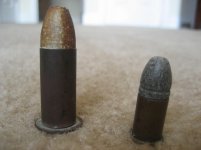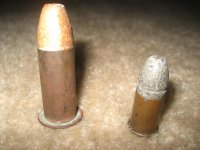I've only visited this forum once or twice, so I apologize if I'm asking questions which have already been covered elsewhere. I have a question about the following two cartridges, which look similar but not identical to cartridges I am familiar with:
1. Maynard cartridge, .50 caliber. This cartridge was sold to me as a Maynard, and it looks like one to me. A quick internet search also shows several identical cartridges for sale. However, I have never seen anything quite like it in any reference works; it seems to be a hybrid of the the blunt-nosed and round-nosed bullets (like TT 78 and 80, or MM 88). Is this cartridge a later, post-war variant? Or is it a reconstructed cartridge, where a blunt-nosed bullet has been reinserted into its cartridge, but not as far as originally, making it look like a very long blunt-nosed cartridge?
2. Henry cartridge, .44 caliber. This has some similarities to Henry cartridges in reference works (TT 60B or MM 161), and it looks like a Henry. It is also stamped with an "H" on the base, and I would think that if it were made after 1866 it would not be stamped with the "H"...maybe a "W" for "Winchester." But the case is shorter than others, and the bullet seems to have a ring with serrations in it, which I have not seen in other Henry cartridges. Is this a post-war bullet, perhaps produced right before New Haven Arms Company changed its name to Winchester?
Thanks for the help, and sorry again if these are dumb questions.
1. Maynard cartridge, .50 caliber. This cartridge was sold to me as a Maynard, and it looks like one to me. A quick internet search also shows several identical cartridges for sale. However, I have never seen anything quite like it in any reference works; it seems to be a hybrid of the the blunt-nosed and round-nosed bullets (like TT 78 and 80, or MM 88). Is this cartridge a later, post-war variant? Or is it a reconstructed cartridge, where a blunt-nosed bullet has been reinserted into its cartridge, but not as far as originally, making it look like a very long blunt-nosed cartridge?
2. Henry cartridge, .44 caliber. This has some similarities to Henry cartridges in reference works (TT 60B or MM 161), and it looks like a Henry. It is also stamped with an "H" on the base, and I would think that if it were made after 1866 it would not be stamped with the "H"...maybe a "W" for "Winchester." But the case is shorter than others, and the bullet seems to have a ring with serrations in it, which I have not seen in other Henry cartridges. Is this a post-war bullet, perhaps produced right before New Haven Arms Company changed its name to Winchester?
Thanks for the help, and sorry again if these are dumb questions.



